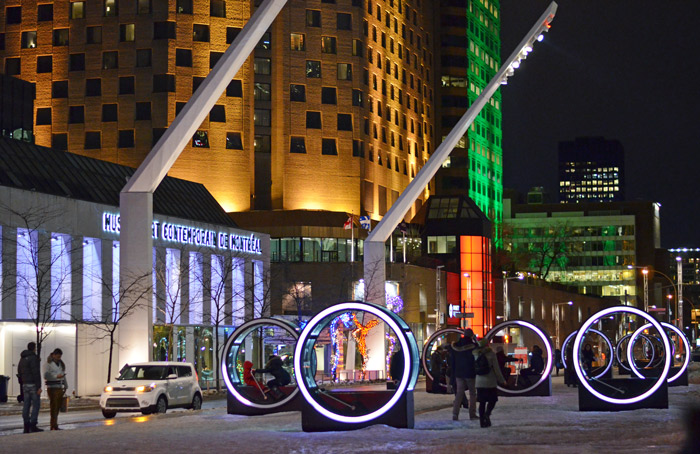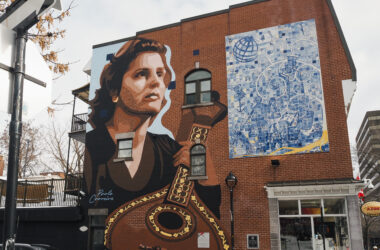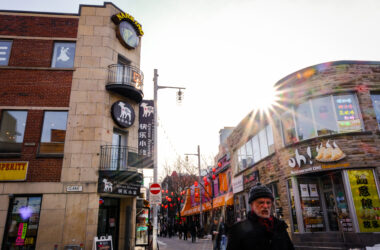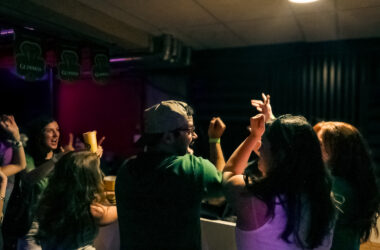From Dec. 8 to Jan. 27, anyone walking through Quartier des Spectacles in downtown Montreal will be able to experience and interact with 13 large luminescent wheels scattered around the Place des Festivals. These are the product of Montreal’s annual Luminothérapie competition, launched Dec. 10, 2015. The winners of the competition, announced in October 2016, were awarded a $300,000 production budget to publicly display their interactive installation over the winter months.
This year’s winning design, known as Loop, is more than just an art exhibit. Jonathan Villeneuve and Olivier Girouard, the artists behind the installation, describe the wheels as manually-activated ‘machines.’
Each wheel depicts a different fairy tale through a series of images on the inside of a vertical cylinder, akin to a life-sized zoetrope. Visitors are able to sit inside the cylinder and rotate the images by pushing a metal bar back and forth, creating a short stop-motion animation. A musical score accompanies the rotating pictures, as well as a spinning, colour-changing light on the outside of the wheel.
The project itself took almost a year to become reality. The initial proposal was presented in January 2016. Once Villeneuve and Girouard were chosen as finalists, they had three weeks in March to put together a plan with a budget and deadline. It took them until the end of September to have a working prototype with all the components, and by the time all the parts had been ordered for the final product in late October, they only had five weeks left to build the thirteen wheels.
“We didn’t sleep a lot […] I think we spent four to five months working seven days a week,” Villeneuve said. “I think I can count on one hand the days where our planning for the day went exactly according to plan.”
The competition required visual, auditory, and interactive components. To meet these requirements, the two artists based the final machine around three main technical inspirations.
It began with the zoetrope, which is a device that can best be described as the equivalent of an animated GIF before film had been invented. It works by spinning a series of images on the inside of a cylinder, creating the illusion of movement. The artists were also inspired by the design of a music box, a metal barrel with strategically placed pins, that when rotated plays a musical score on a loop. Finally, Villeneuve and Girouard drew from the railway handcar, a manually-powered car activated by one or two people pulling levers, as their third source of inspiration.
These three objects all require manual activation for them to work. The whole project revolved around these three ideas and what they had in common.
“It’s pretty satisfying how we managed to [combine] these three elements that were really far apart into one single device,” Villeneuve said. “It’s the idea of [transforming] these three past technologies […] into really futuristic devices. It often makes people think of a time machine, so there’s really these elements of the future and the past meeting in one device.”
Because operating the machines was can feel complicated for new users, Villeneuve and Girouard initially worried that it would be difficult for the public to understand how to use the installment.
“We really wanted to come up with something that was totally new and invented, but still refer to people’s intuition and make it really obvious […] how to use it,” Villeneuve commented.
In previous years, some art installments in the Place des Festivals were much more intuitive to use, such as the seesaws of Impulse, presented for the Luminothérapie 2015-2016 competition, or the swings of 21 Swings, which has returned each spring since 2011. However, the public reaction this year was extremely positive.
“[The exhibit] worked really well. There was no need to explain to people how to use it, they just understood and found their own ways,” Villeneuve said.
The name of the exhibit itself—Loop—reflects the workings of the simple mechanisms behind each individual machine that Villeneuve and Girouard have combined into one. Although, this title wasn’t the artists’ first idea; they initially chose the title ‘Chimera,’ but after deliberation, ultimately decided against it.
“We both liked Chimera […] this weird machine with different parts, but then to explain it, it’s already complex. For a public art installation people need to understand right away. It needs to be fast and easy,” Girouard added.
Both artists agreed that in the end it’s the public that decides on the name of the installation, regardless of its official title. Last year’s exhibit for Luminothérapie was titled Impulse, but most people referred to it by its appearance, as the ‘seesaws.’
Despite their anxiety over its title and user-friendliness, the final version of Loop was deemed a success for the artists.
“Even if you take so many different paths to get to the goal, it’s fun when you reach [it] and you realize, ‘That’s exactly the idea I had at first.’ Nothing really changed,” Girouard said.
For more information on Loop visit the Quartier Des Spectacles website.









